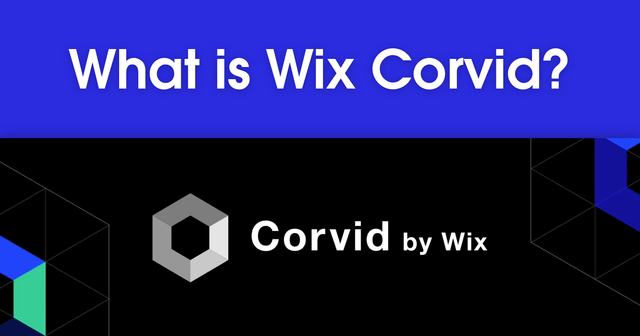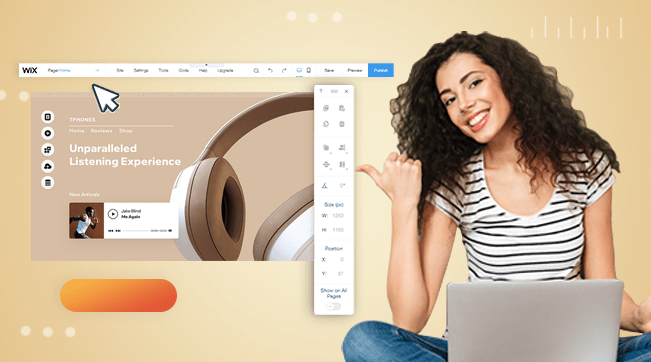Wix and Squarespace are two of the largest players in the website-building industry. While both platforms are celebrated for their drag-and-drop editors and beginner-friendly interfaces, the real battle in 2025 is about value. Both are packed with top-tier features in their starter plans that won’t break the bank, but there can be only one winner.
Wix and Squarespace often top our recommendation lists, so I set out to compare these two web-building giants to find the ideal choice for you. Second best won’t cut it for a professional website, especially if you’re considering the more feature-rich, expensive plans.
After creating my own website using both builders and conducting exhaustive research, Wix seems to be the best choice for most users, and for good reason. Read on to discover for yourself which builder is right for your needs, or go ahead and sign up to Wix for free right now.
1. Wix vs Squarespace Pricing
Overall, Squarespace Is Slightly More Affordable
Wix offers a free plan with basic features, while Squarespace only has a 14-day free trial and no free plan. Both website builders offer four paid plans with features similar to their closest-priced counterparts. However, Squarespace offers better annual pricing on all plans except the starter.
Both Wix and Squarespace charge proportionately more if you decide to pay monthly. Conversely, Wix lets you set a billing period of up to three years, which is significantly more affordable than Squarespace. However, as annual billing is the go-to option for most users, I’d say that this category goes out to Squarespace.
Here’s What You Get for Free
If you’re looking to spend nothing on your site and keep it, Wix is the only one offering a free plan. Your site will have a Wix subdomain and a fair bit of Wix advertising, and you won’t be able to access any store functionalities. A free Wix site is not an option for a professional website, but it works well enough for a school project or an RPG campaign.
Squarespace has no free plan, but you can take it for a test drive with the 14-day free trial. Though shorter than the standard 30-day free trial, 14 days is usually enough to decide if Squarespace suits your style.
Here’s What You Get If You Pay
If you choose to pay annually, the Wix Light and Squarespace’s Personal plan will cost you about the same. They’re both very similar in terms of functionality, too. They give access to a free domain for one year, a website free of branding, and a modest amount of storage space.
Just like the name suggests, these plans are ideal if you want a site for purely personal purposes, and since they’re both so similarly priced, the choice comes down to which builder you’d prefer. That gap widens a bit when we start to look at business plans.
Wix and Squarespace’s “Business” plans (both marked as “recommended” on their pricing pages) will come up to $39.00 and $23.00 per month, respectively. Both plans give you access to e-commerce capabilities, site analytics, and marketing integrations.
Here’s a comparison table to see what you get from both Wix and Squarespace’s “personal” and “business” plans at a glance:
| Wix Light | Squarespace Personal |
Wix Business |
Squarespace Business |
|
| Starting price |
$17.00 | $16.00 | $39.00 | $23.00 |
| Free domain (1 year) |
✔ | ✔ | ✔ | ✔ |
| Bandwidth | Unlimited | Unlimited | Unlimited | Unlimited |
| Storage | 2 GB | Unlimited | 100 GB | Unlimited |
| SEO optimization |
✔ | ✔ | ✔ | ✔ |
| Analytics | ✘ | ✔ | ✔ | ✔ |
| E-commerce features | ✘ | ✔ (limited to digital products) |
✔ | ✔ |
Both Wix and Squarespace offer four paid plans with similar features compared to their closest-priced counterpart. However, Squarespace always offers a better annual price for all plans except the starter one.
2. Ease of Use
Getting Started With Wix and Squarespace
Wix and Squarespace are as user-friendly as website builders come. For both, all you have to do is head over to their respective pages, create an account, and select create website. After that, you have three options: start with a template, a blank canvas, or use either builder’s proprietary technology to design a custom site for you.
In Wix’s case, this technology comes as an AI chatbot. For example, if you’re launching a local restaurant website, the Wix AI chatbot might ask for details like your restaurant’s name, cuisine type, and even sample menu items to generate a layout tailored to a food business. If you plan to have a blog, Wix will even ask for any topics you’d want to include.

Once you’re done “talking” to this chatbot, Wix will redirect you to your website’s dashboard, which will now include apps, text, and images based on your answers. However, this isn’t the same as letting Wix AI design your website for you. You’ll still have to click Design your website to create its visual identity.
You can still start with a pre-made template at this point. If you feel like letting Wix do all the hard work for you, you can also just let Wix generate your website’s template automatically.
Squarespace doesn’t have the same AI chatbot as Wix, but it offers a more versatile template creator called Squarespace Blueprint. With Squarespace Blueprint, you can build a template that is exclusively created for your site. Simply navigate to the template page and select build your own template.
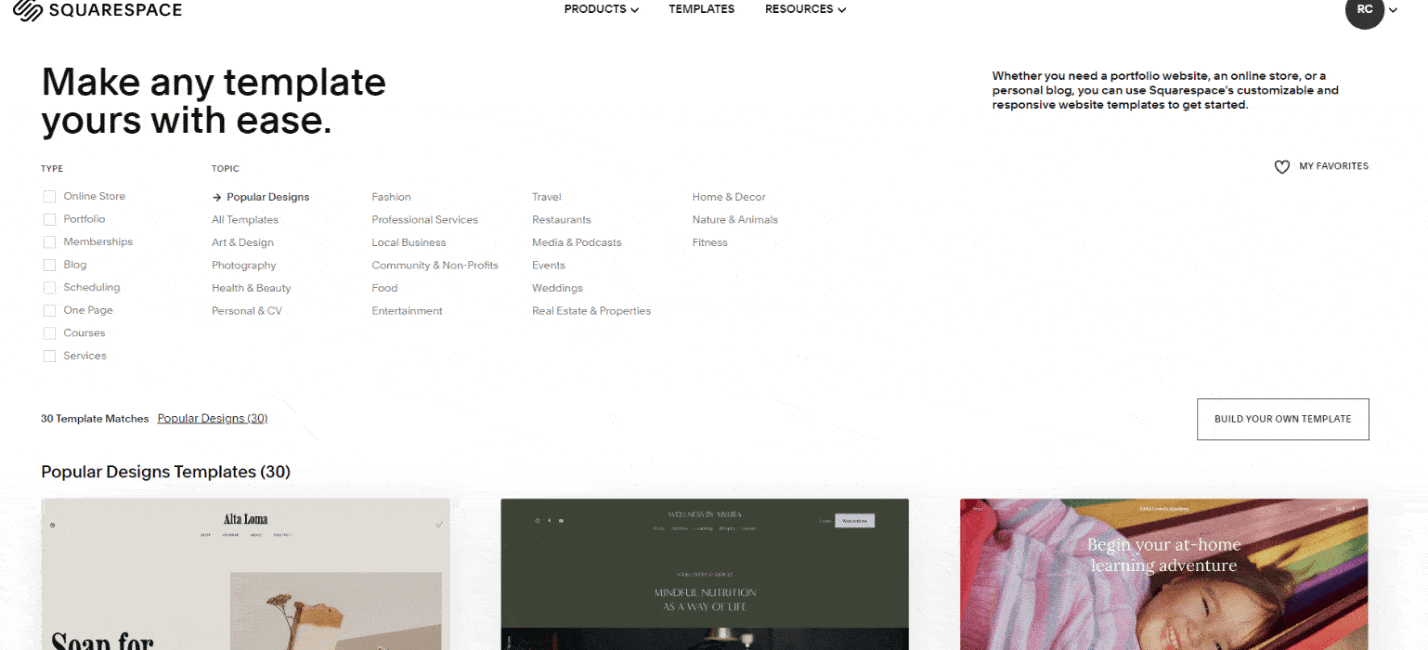
After you write down your website’s name, Squarespace will let you build your homepage by choosing what content to add from various pre-made sections. Then, you’ll get to pick which extra pages you want to add, the color palette for your site, and its typography. Finally, you can start editing or let Squarespace’s AI text generator pre-write some content by filling out a quick description of your business.
Though Wix’s AI chatbot gives slightly more personalized results, both builders offer simple tools to let you create a customized starting point for your ideal website. You can also go with the traditional route of selecting any of Wix or Squarespace’s high-quality templates and manually editing your site’s design.
Wix and Squarespace Are Easy To Use, Just in Different Ways
You’ll hear a lot about structured and unstructured design when comparing these two in terms of actually customizing your site. But what does that mean, exactly? Wix provides an “unstructured” design because it’s a proper drag-and-drop editor. Essentially, you can choose any element from Wix’s massive catalog and place it anywhere you want on your site.
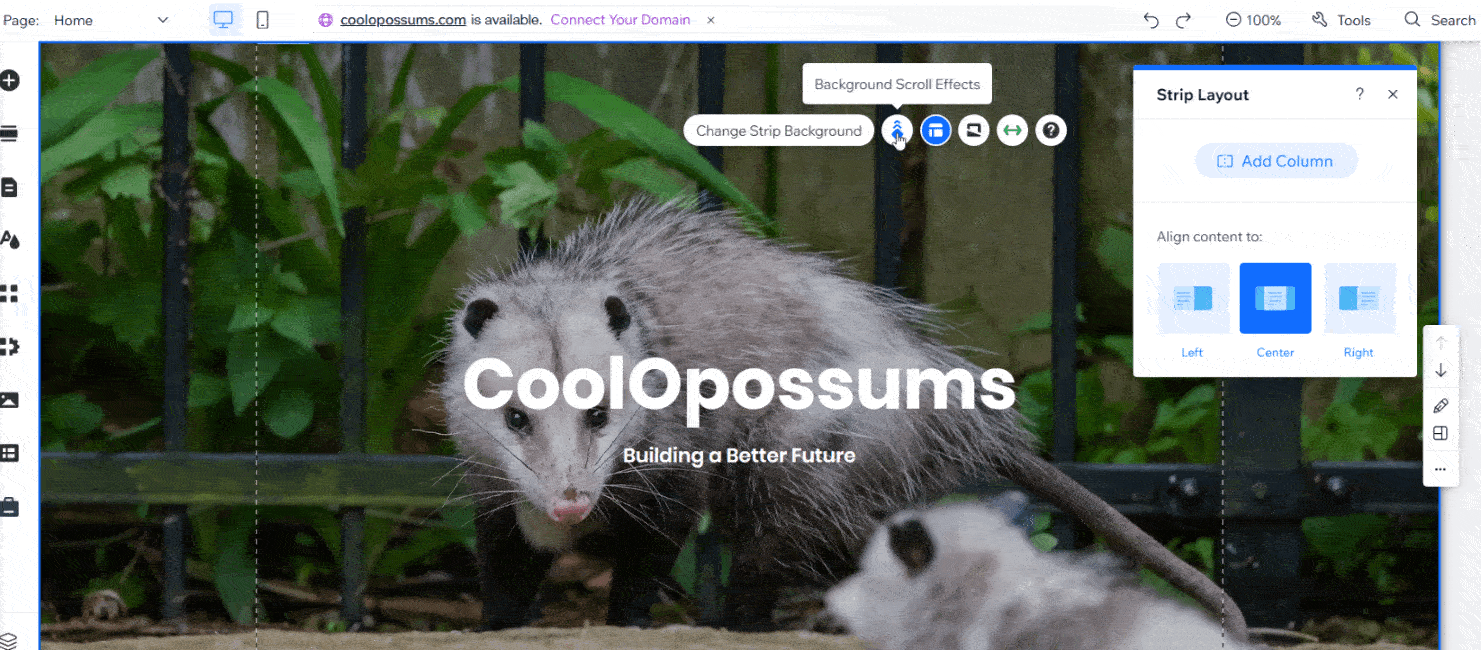
This might sound awesome on paper, but it can also be overwhelming if you don’t feel comfortable with your web design skills. After all, Wix’s complete creative freedom also means you’re free to mess up your site’s structure, which is much easier than it seems, even for professionals.

Wix allows you to place pre-made content blocks (known as sections) onto your page, and you can easily edit global styles. So, it’s not like you’re entirely on your own when designing your site. But, almost paradoxically, you wouldn’t be taking full advantage of Wix’s flexibility if you let pre-made sections do all the work for you.
Squarespace, on the other hand, has something that is best described as a section editor. You start by adding sections and defining the structure of your site, and you can then add custom elements to almost any region. However, you can’t add a block (Squarespace’s verbiage for widgets) anywhere in a section. Squarespace implements a grid system to ensure that your content remains well-structured.

These two builders feel different. Theoretically, you could go section-by-section with Wix or add a bunch of blank sections and fill them with content blocks with Squarespace. Establishing a set structure before tweaking things makes more sense when creating with Squarespace. Conversely, Wix encourages a more fluid approach, where you start working with individual components and adjust the overall structure as you progress.
Though both systems are straightforward to use, especially considering the creative freedom they give you, I’m giving Squarespace the win in this category. Both builders make it easy for anyone to create their own site, but Squarespace makes it considerably harder to create a poorly structured or bad-looking site.
3. Templates
Wix and Squarespace Offer Some of the Best Website Builder Templates
No matter how you look at it, Wix and Squarespace have some of the best templates out of any website builder. I’ll admit that this is, in part, a personal opinion, but both builders hit the right spot when it comes to template quantity, quality, and customizability.
While platforms like WordPress.com or Shopify offer thousands of third-party templates, they often come at a cost and are harder to customize without plugins. Other builders might offer templates that all look sort of the same or strict layouts that you’ll be stuck with if you want to edit your site. Wix and Squarespace’s templates are free, numerous, and neatly designed.

Wix offers over 2500+ templates separated into 19 categories and 79 sub-categories. These categories separate each template based on utility and topic, which means that whether you’re looking to create a sports blog or a recycling facility website, there’ll be at least one template that’s ideal for you (I’m not joking about those examples – there really is a template for recycling facilities).
Also, as we discussed previously, Wix offers incredible customization freedom. Turning a spiritual wellness podcast template into a stunning website for selling pet clothes is definitely possible.
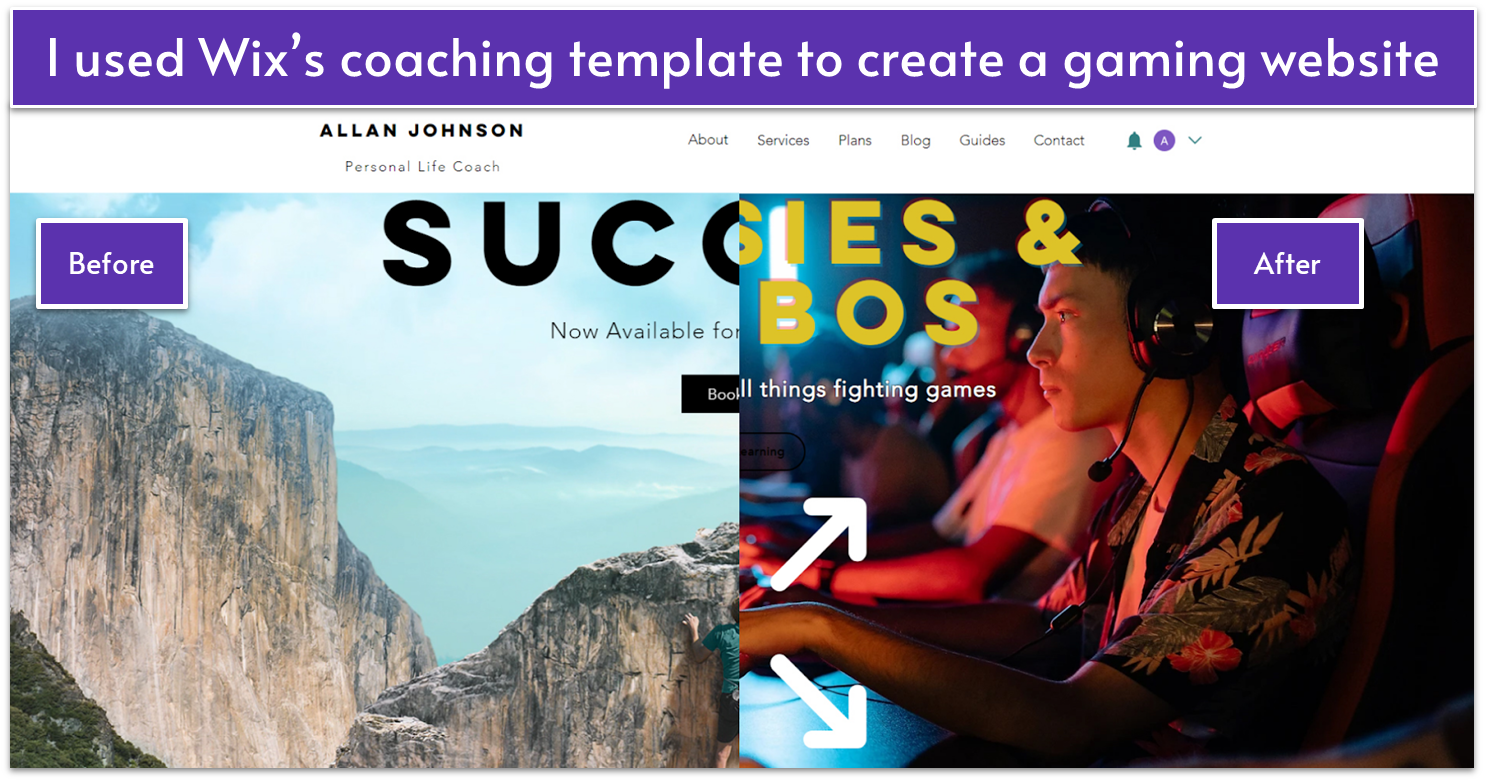
I won’t lie. There are bound to be weak links in a list of 2500+ templates. However, most Wix templates are unique, well-designed, and visually attractive. On the other hand, Squarespace offers a more limited selection of over 180+ templates (which is still impressive compared to the competition). These templates are separated into 21 topics based on content and 8 types based on functionality.

Though Squarespace’s offering is smaller, almost every template in its catalog looks sleek. There’s a reason why you might hear that Squarespace has “award-winning templates.” Sure, the awards in question were the Webby Awards that took place over a decade ago, but still, Squarespace templates are remarkable.
Here’s a quick rundown of how both templates compare:
| Wix Templates | Squarespace Templates | |
|---|---|---|
| Quantity | Over 2500+ templates available | Approximately 180+ templates |
| Design Style | Wide variety ranging from modern to niche-specific options | Curated, clean, and professional designs ideal for creative work |
| Customization Flexibility | Highly customizable with an unstructured (drag‑and‑drop) editor | More structured customization (grid‑based, ensuring design consistency) |
| Responsiveness | All templates are mobile-friendly; however, full responsiveness may require extra tweaking | All templates are fully responsive out of the box |
| Template Switching | Cannot switch templates once live (requires starting over) | Also fixed after publishing |
This section is incredibly close to being a tie. However, considering that most templates in Wix’s selection of over 2500+ are great, I’m compelled to give it the win. That said, you should consider Squarespace if you’re looking for gorgeous, eye-catching templates with minimalist designs.
4. Apps and Add-Ons
Squarespace Integrates Services – Wix Has an App for That
One of Squarespace’s greatest strengths is how seamlessly it integrates with third-party services. Though you might not see an app market at first, if you look closely, you’ll notice that features like audio embedding and appointment tools are managed by other services like SoundCloud and Acuity.
These integrations are smooth, almost seamless. Even when you use a third-party service, it still feels like you’re using Squarespace and not jumping over to a different site. Most importantly, all official integrations include full support from Squarespace’s team. That doesn’t mean Squarespace doesn’t offer an app market, though – it’s just a little harder to find.
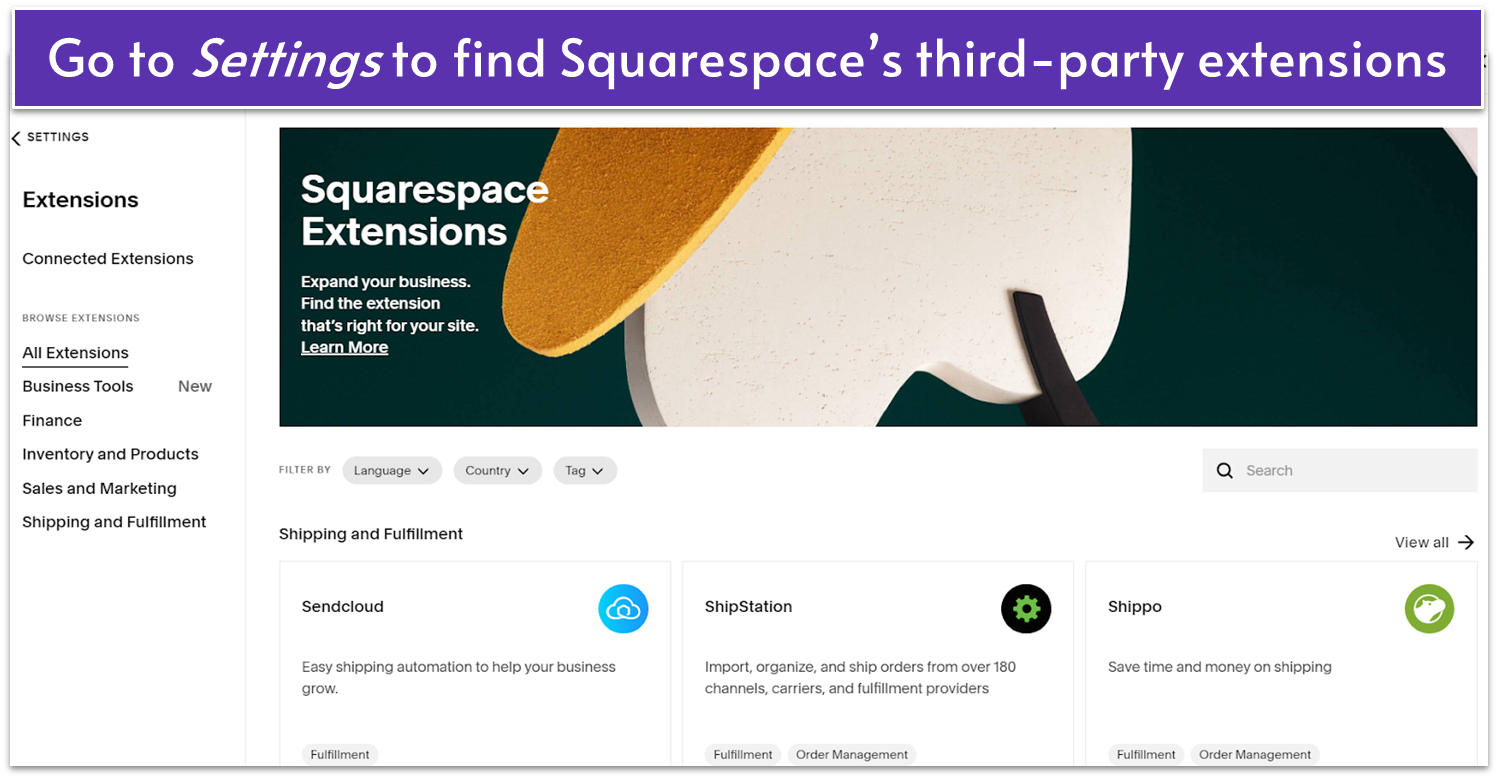
On your site settings tab, all you have to do is scroll down to the Third Party Tools section and click on Extensions to access Squarespace’s integration market. There, you’ll find dozens of sections specifically catered to business management under categories such as Business Tools and Shipping and Fulfillment.
Conversely, Wix adopts a “more is more” approach to its apps. Though it also offers built-in integrations with services like Vimeo and SoundCloud, its app market is more extensive and easier to find. Wix’s app market offers hundreds of third-party apps for everything from third-party integrations to analytics, fun 3D effects, and image editing tools.

This pattern repeats across most categories. While Squarespace carefully curates the elements it incorporates into the builder, Wix’s approach is more of a free-for-all.
Squarespace offers 180+ carefully designed templates for professional websites. Wix has over 2500+ templates for anything you can think of. Squarespace offers a few but tried-and-tested integrations with business tools. With Wix, you’re as likely to find an app to keep track of your website’s metrics as one that makes it snow somewhere on your page for whatever reason.
Though it’s easy to take cheap shots at some of the more baffling apps in Wix’s market, in the end, it’s still quite impressive. The sheer number of apps on display means that while you might see more useless apps, you also unlock many potentially useful apps.
5. E-Commerce
Both Have Strong E-Commerce Tools – Squarespace Refines Them More
Squarespace and Wix go almost toe-to-toe with regard to e-commerce. Although neither is a dedicated e-commerce platform, they both provide robust features such as automatic tax calculation, comprehensive inventory management, and support for digital products and social media sales.
In addition, Wix offers a wide array of payment gateway integrations (including Wix Payments, Stripe, PayPal, Apple Pay, and Google Pay), while Squarespace uses its native Squarespace Payments along with integrations to Stripe, PayPal, and Apple Pay. Both builders handle their e-commerce interface through a dedicated dashboard, so there’s not much difference there, either.
Naturally, you don’t get as many layout options when designing your store pages, but both Squarespace and Wix have a variety of layouts that you can try. With either service, your store’s aesthetics will change to match your overall site theme.
Squarespace features built-in real-time shipping tools (offering quotes from USPS, FedEx, and UPS) and customizable shipping rules, whereas Wix provides shipping calculators and supports third-party shipping integrations. Since e-commerce integration is built into both services from the beginning, it all looks and runs smoothly.

Note that you can’t sell products on Wix’s cheapest plan. Squarespace’s Personal plan includes some basic e-commerce functions, but it’s not a viable long-term solution since you’ll have to pay high transaction fees.
Keep in mind that payment processor fees (like Stripe or PayPal) are charged separately, usually around 2.9% plus 30¢ per transaction. To access more e-commerce capabilities and lower transaction fees, you must upgrade to Wix’s Core plan or Squarespace’s Business plan.
Squarespace handles its integrated dashboard in a way that (seems to me) is more intuitive. Some of its more specialized tools come built-in, while you might need a third-party app from Wix for the same functionality. But frankly, that’s the only aspect preventing this category from being an outright draw.
6. Blogging
Squarespace Has the Better Writing Experience, but Wix Has More Content Tools
The blog systems on Squarespace and Wix are very similar, but not quite as similar as the e-commerce features. With either service, you’ll have a fully functioning blog with options to save drafts, schedule your posts for publishing, and add categories.
One big difference is that Wix’s blog post editor is a separate interface from the rest of your site. It’s a decent editor, but you can’t preview your post’s final look while writing. Wix is a site builder, so you should be able to do that, right?
Meanwhile, you write blog posts on Squarespace in a way that feels like designing a page in the drag-and-drop editor. You don’t get the same design and layout freedom, but you get a good look at how your post will appear to your readers.
However, if you prioritize content marketing, Wix excels with its blogging tools. You can use its integrated AI tool to create your next blog post’s outline and content. Wix also offers monetization tools for setting up exclusive paid content and displaying Google Ads. Then, you can track site engagement through the comments manager and analytics.
7. Marketing
Wix Offers a Complete Suite of Marketing Tools
Squarespace is undoubtedly a heavy hitter when it comes to marketing. Not only does Squarespace make it exceedingly simple to create email campaigns, but you also get the same focus on stunning visuals that you get on the page editor, so you can really “wow” potential clients with your email campaigns.
Beyond that, Squarespace also does an admirable job of letting you track your campaign’s performance. Besides email campaigns, Squarespace’s integrated marketing dashboard lets you control settings like your SEO appearance, add promotional pop-ups to your page, or even create ads for Meta-managed sites (such as Facebook and Instagram).
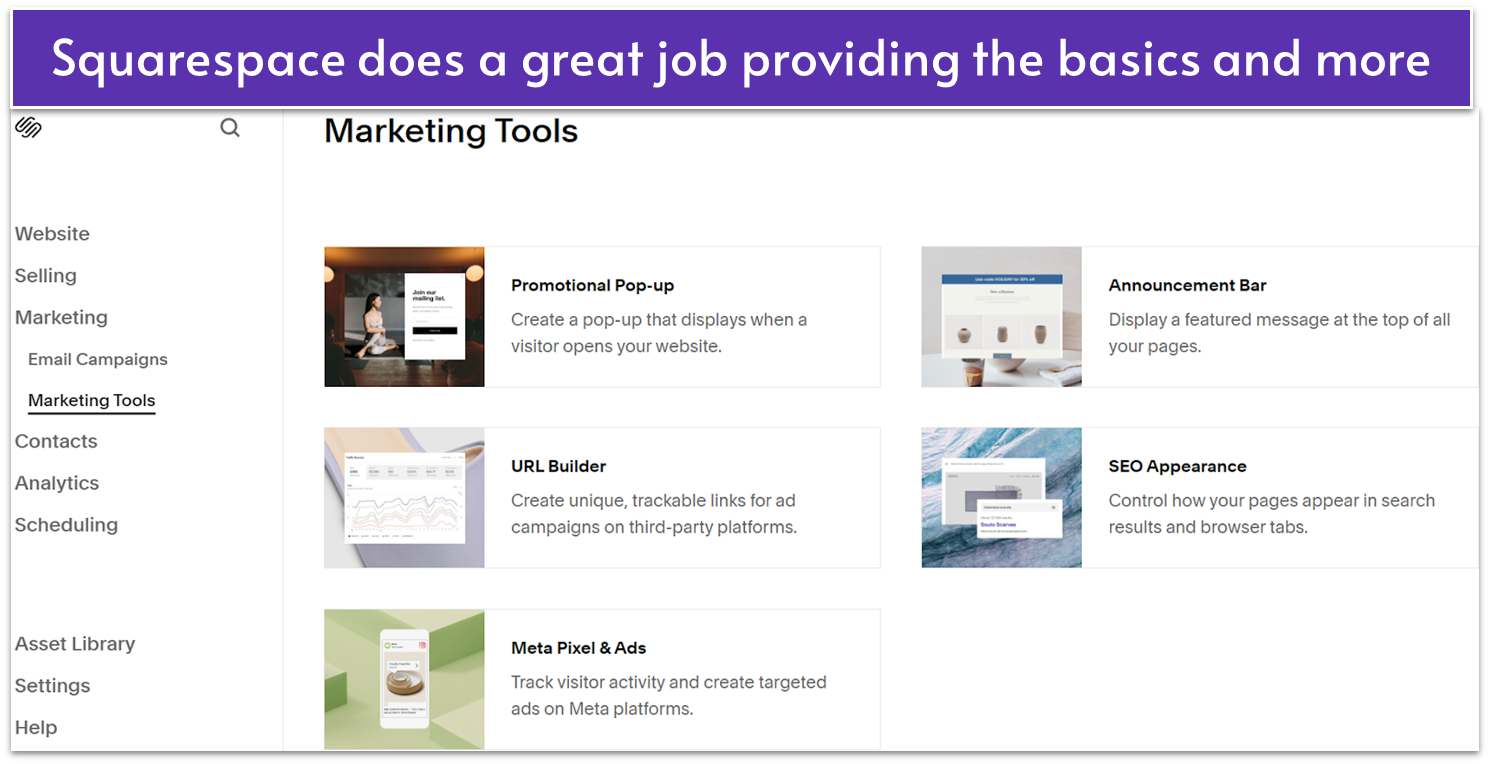
Still, the title gives it away that Wix is the winner for this section. So, if Squarespace’s marketing tools are so good, how does Wix come out on top? Even though Squarespace offers a useful suite of marketing tools, and I’d say its marketing dashboard is more intuitive, Wix offers far more valuable marketing tools than Squarespace.
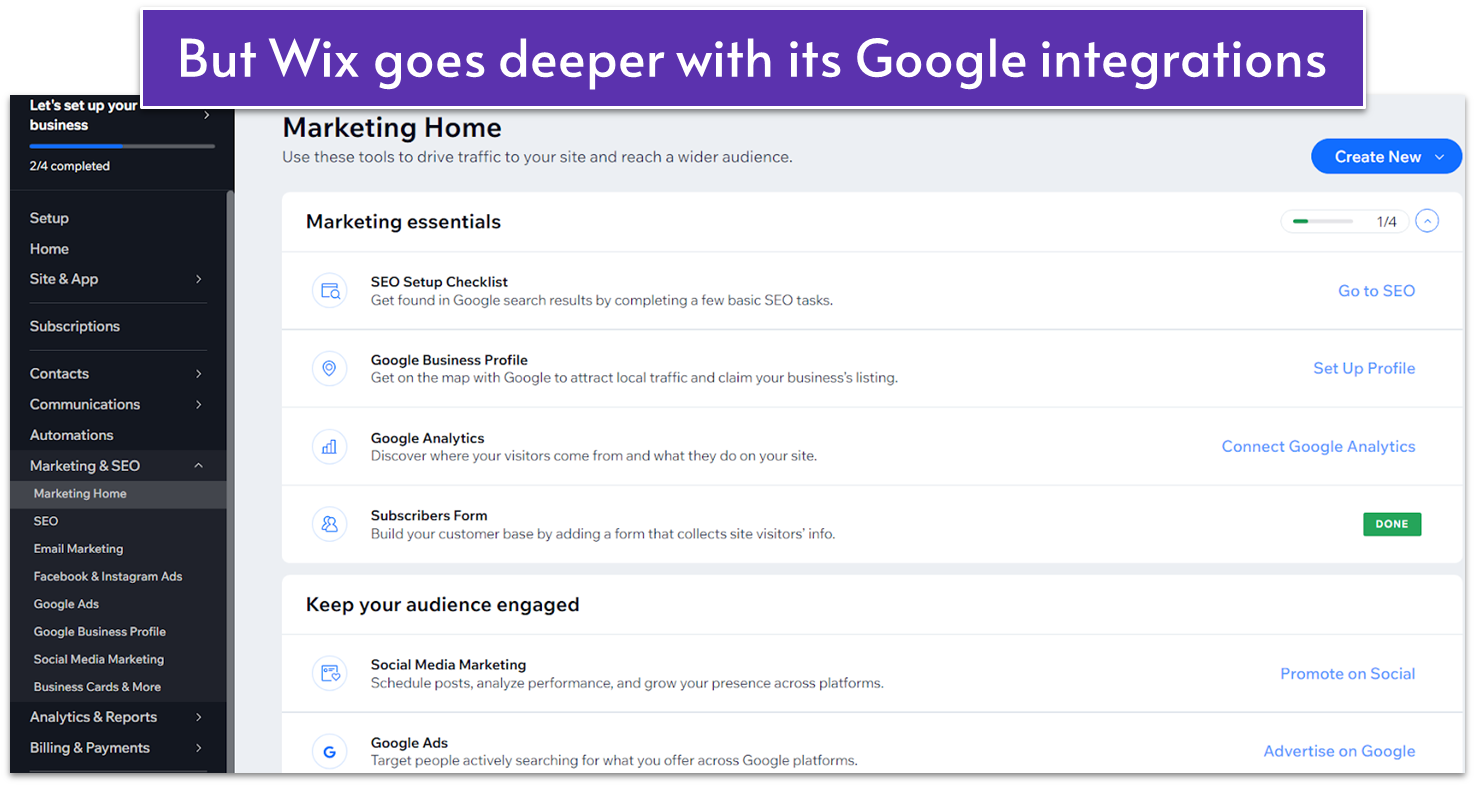
Wix offers every tool that Squarespace does on its marketing dashboard. However, it goes a step further by allowing deeper integration into SEO settings. You can connect to Google Ads, obtain a Google Business profile, and create custom visitor forms. Moreover, Wix enables the creation of custom branding elements such as logos, t-shirts, and business cards.
Even if business cards are less common today, the option is a nice bonus. So, Wix takes the crown here.
8. SEO
Wix Takes SEO to a Whole New Level
Once again, Squarespace offers simplicity while Wix leans into flexibility. I told you it’d be a recurring theme.
Besides the basic things like meta tags and URL editing, Wix allows you to edit URL redirects and even Robots.txt files. Those files “communicate” directly with web browsers and directly influence your site’s search engine rankings.
If you want a way to start optimizing your site quickly, Wix has you covered there, too, with an AI-driven tool called Wix SEO Setup Checklist. Like before, all you have to do is answer a short set of questions, and Wix will automatically adjust your site’s SEO settings based on your answers.
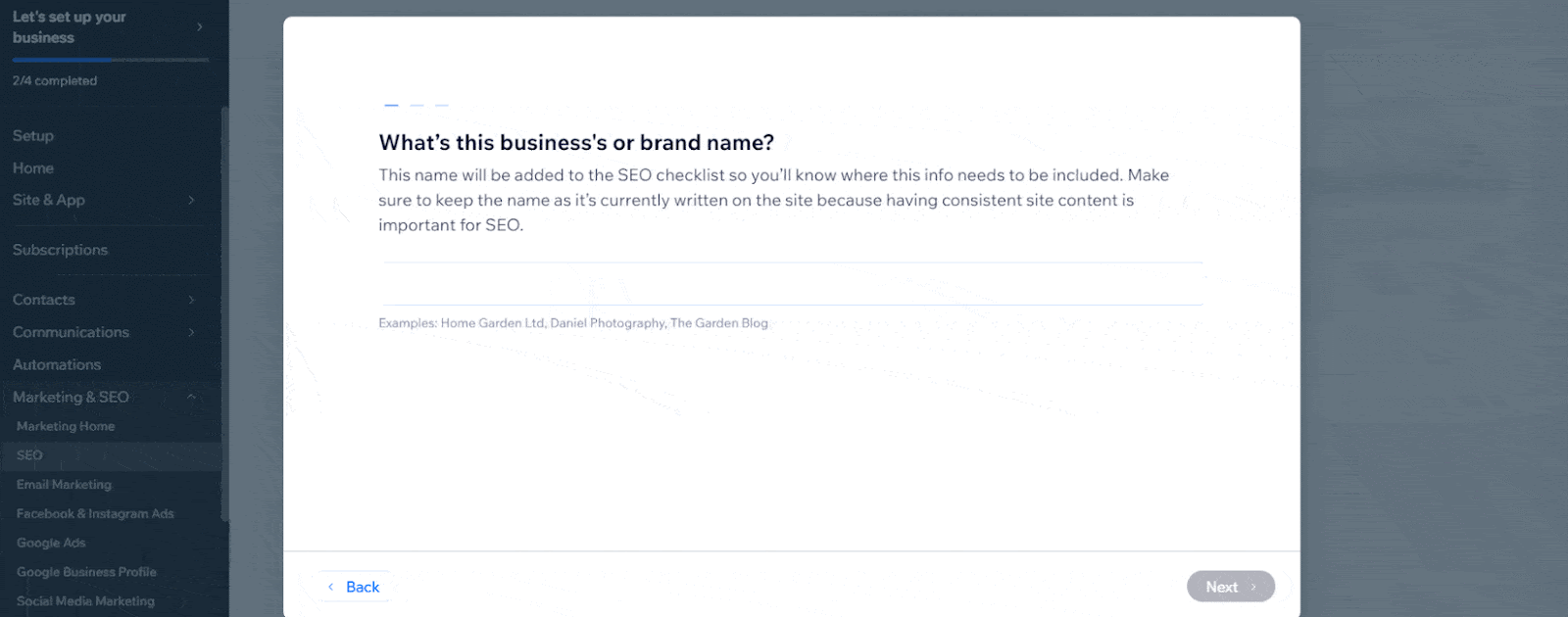
Squarespace, on the other hand, offers just the essential SEO tools you’d expect from a competent builder. You can change tags and meta descriptions and make basic URL adjustments – and that’s pretty much it.
However, it’s worth noting that Squarespace also lets you hire an SEO expert to optimize your site for you. Since it’s a paid service and Squarespace still offers fewer base SEO tools than Wix, it’s still not enough to score it a win.
9. Customer Support
Squarespace Support Is Simply More Efficient
In my experience, Wix’s customer support has always been rather hit-or-miss. Sometimes, you get an efficient response to whatever question you have in minutes. Other times, you get dragged around in a loop of links and articles that don’t answer your question.
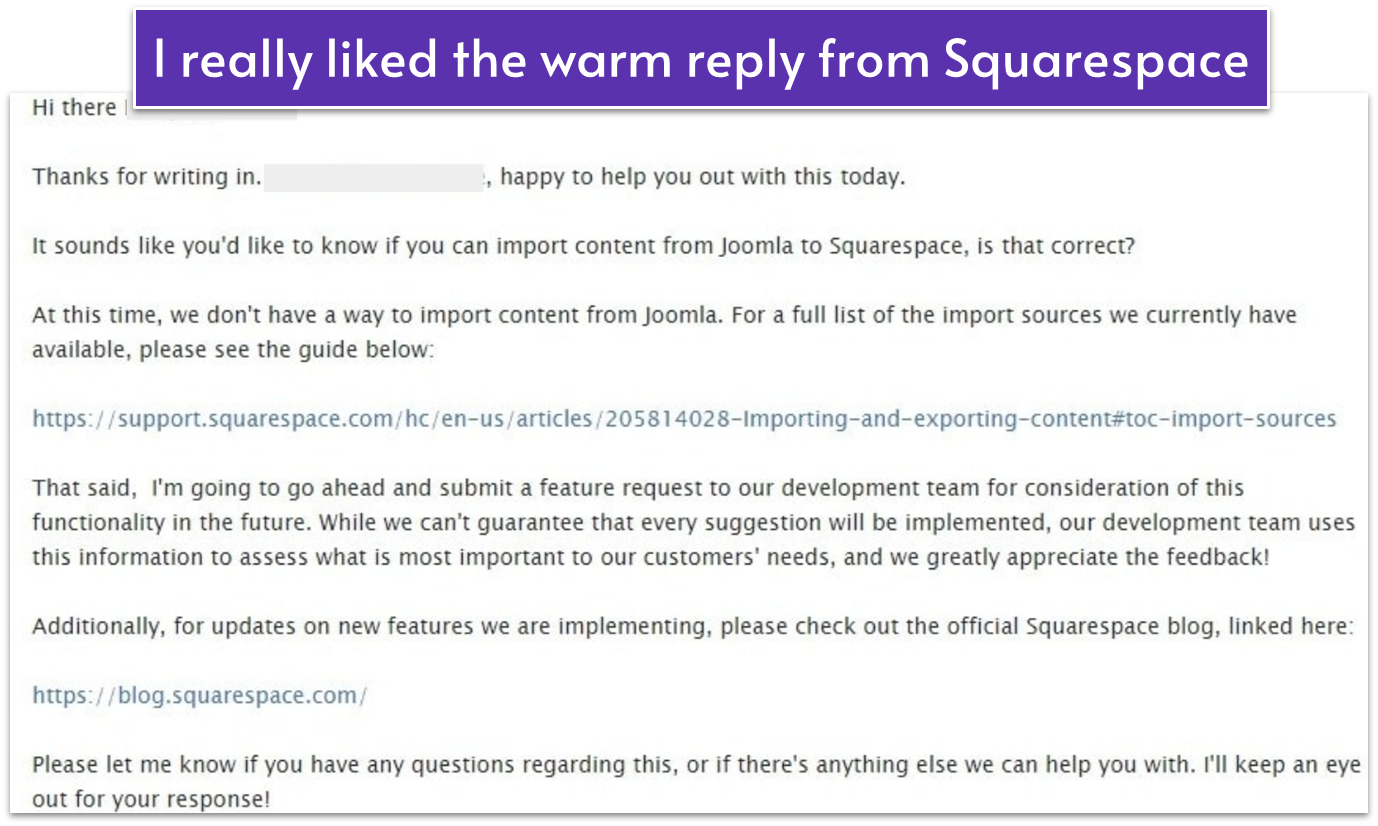
Squarespace’s support is a different story entirely. In his independent review, my colleague found that Squarespace is consistently efficient, regardless of whether you contact them through live chat (Mondays to Fridays, 4 a.m. to 8 p.m. EST), email ticket, or even on the official Squarespace forum.
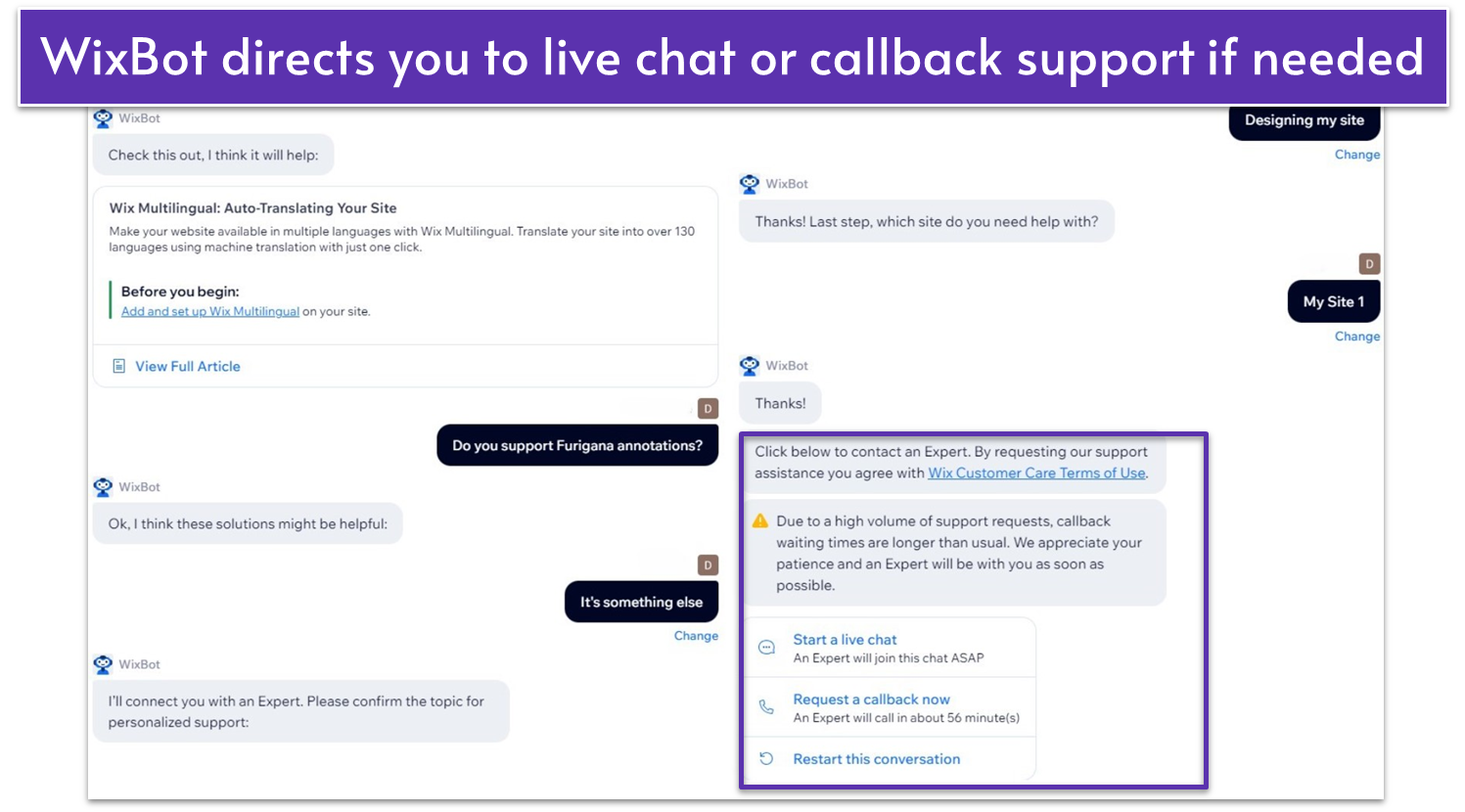
If you prefer talking on the phone, Wix’s support might be better suited for you. Wix offers 24/7 phone support in English, while callback services in other languages are available during different business hours. This is something to consider if you’re not much of a texter, but take note that you must first use WixBot for assistance. It will only direct you to live chat or callback support if it can’t provide useful answers.
Though Wix’s support has its moments, I’m afraid this one is an easy win for Squarespace.
10. AI Tools
Wix Integrates AI Better
Wix’s AI Website Builder has a user-centric design. It asks you a series of questions to understand your needs and preferences and then generates a customized website layout accordingly. It also has AI tools available to help you build your site sections, logos, product descriptions, emails, and more.
Unlike other AI builders I’ve tested, Wix’s tool feels refined and well-integrated. It uses advanced AI algorithms, including integrations with the latest GPT for content creation and DALL-E for generating custom images. This guarantees you’ll get highly personalized and good-looking results. You can take a look at my colleague’s article on the best AI website builders to see why Wix ranks first.
While Squarespace does not emphasize an AI-driven creation process as much, it does offer some AI-enhanced tools for optimizing images, structuring content, and improving SEO. These can help you create a professional-looking website without needing extensive design knowledge, so I wouldn’t cast them aside.
Wix Delivers Complete Site-Building Freedom
As much as I like Squarespace’s approach to structured design and business-oriented features, you simply can’t beat Wix’s complete creative freedom. If you truly want to make any site imaginable, Wix is the only platform to do that confidently if you’re not a professional designer.
Wix’s massive gallery of templates, extended app store, and toolbox of marketing features also make it a more versatile option. It doesn’t matter if you need a website for your dental office, law firm, or new book. Wix can help you build that website.
However, You Should Use Squarespace Anyway If…
Squarespace emerges as the clear front-runner for those aiming to build a website with stunning aesthetics, particularly for business purposes like portfolios or galleries. Its highly curated editor not only equips you with the latest features but also prevents gaffes and awkward mistakes. Essentially, you’re guaranteed to create a website that engages visitors and makes a lasting impression.
market
dropshipping and
print-on-demand options
inventory management tools
social media ads
media integration with analytics
app, and prompts
SEO-specific app
start at $17.00
premium plans start at $16.00
and live chat support in various
languages
webinars, community forums
compliance, anti-DDoS
protection, security monitoring,
Bug Bounty Program
security monitoring, 2FA,
anti-DDoS protection
Wix Multilingual, multiple
currencies, global payment
processors
currencies, integrated payment
gateways, support for international
shipping
Google, Adobe, and Monotype
Fonts; custom font upload
supported
supports custom fonts and Google
and Adobe Fonts integration
FAQ
Which is cheaper, Wix or Squarespace?
That depends entirely on your website needs. If you want to create a site for fun or a pet project, Wix offers a forever-free plan – Squarespace doesn’t. However, Squarespace tends to offer lower prices and fewer hidden upsells on its professional plans. Check out the section above for a complete comparison of both builders’ pricing.
Is Wix or Squarespace easier for someone who has never built a website?
Both Wix and Squarespace are exceedingly easy to use for beginners. However, since Wix offers complete design freedom, while Squarespace offers a more on-rail experience, Squarespace might be the better starting point for absolute beginners. Either way, both builders are among some of the most intuitive on the market, so you should have no problem getting started.
Wix or Squarespace for blogging – which is better?
Though Wix offers a wider array of possibilities for website design and functionality, Squarespace streamlines the blogging experience, making it easy to create and maintain an active blog.
What platform is better for portfolios – Wix or Squarespace?
Squarespace is the clear winner for most portfolio sites. Its professionally designed, visually striking templates are optimized for creative work and require minimal tweaking. However, if you need complete creative freedom to design every detail of your portfolio, then Wix’s highly flexible drag-and-drop editor might be more appealing.
Wix vs. Squarespace for e-commerce – which is better?
Squarespace offers an all-in-one e-commerce solution that balances ease of use with powerful features like inventory management, real-time shipping tools, and an intuitive checkout system. Wix provides more customization while supporting multiple payment gateways and third-party plugins, making it ideal for small to medium-sized online stores.
Wix or Squarespace – which is better?
They’re both top options. Do you want a simple but visually appealing site? Squarespace. Do you want a website for an extremely niche topic with custom functionalities? Wix. Remember, however, that those two aren’t the only options, and the best website builder will always be the one that best adapts to your needs. If you’re looking for your ideal builder, I recommend you check out our list of the best website builders in 2025.








![Squarespace Pricing [2025]: Crucial Tips Before You Sign Up](https://dt2sdf0db8zob.cloudfront.net/wp-content/uploads/2018/02/Squarespase-840x430.png)
![Squarespace Pricing [2025]: Crucial Tips Before You Sign Up](https://dt2sdf0db8zob.cloudfront.net/wp-content/uploads/2020/07/louisa.jpg)
